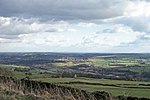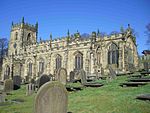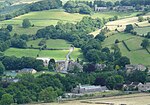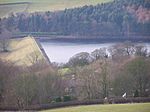High Bradfield

High Bradfield is a rural village 6.5 miles (10 km) north-west of the centre of Sheffield in South Yorkshire, England and within the city's boundaries. The village lies just within the Peak District National Park, 1.3 miles (2 km) inside the park's north-eastern border, is at an altitude of 260 metres (850 feet) AOD, and has extensive views across Bradfield Dale towards Derwent Edge and the Dark Peak. The most striking feature of the village is the medieval Church of St. Nicholas, Bradfield. It is one of only five Grade I Listed buildings in Sheffield.The name Bradfield failed to shift during the Great Vowel Shift from Old English to Broadfield, a name with a double emphasis on its broad stretch of open countryside. and the area around the village is predominantly grazing land with dairy and sheep farming dominating. High Bradfield has a sister village, Low Bradfield, which lies less than 0.7 miles (1 km) to the south-west but is lower down in the upper Loxley valley. The two villages are linked by the steep Woodfall Lane. High Bradfield is in the civil parish of Bradfield, the largest in England, and in the electoral area of Stannington.
Excerpt from the Wikipedia article High Bradfield (License: CC BY-SA 3.0, Authors, Images).High Bradfield
Towngate, Sheffield Bradfield
Geographical coordinates (GPS) Address Nearby Places Show on map
Geographical coordinates (GPS)
| Latitude | Longitude |
|---|---|
| N 53.4288 ° | E -1.5981 ° |
Address
Towngate
Towngate
S6 6LH Sheffield, Bradfield
England, United Kingdom
Open on Google Maps









